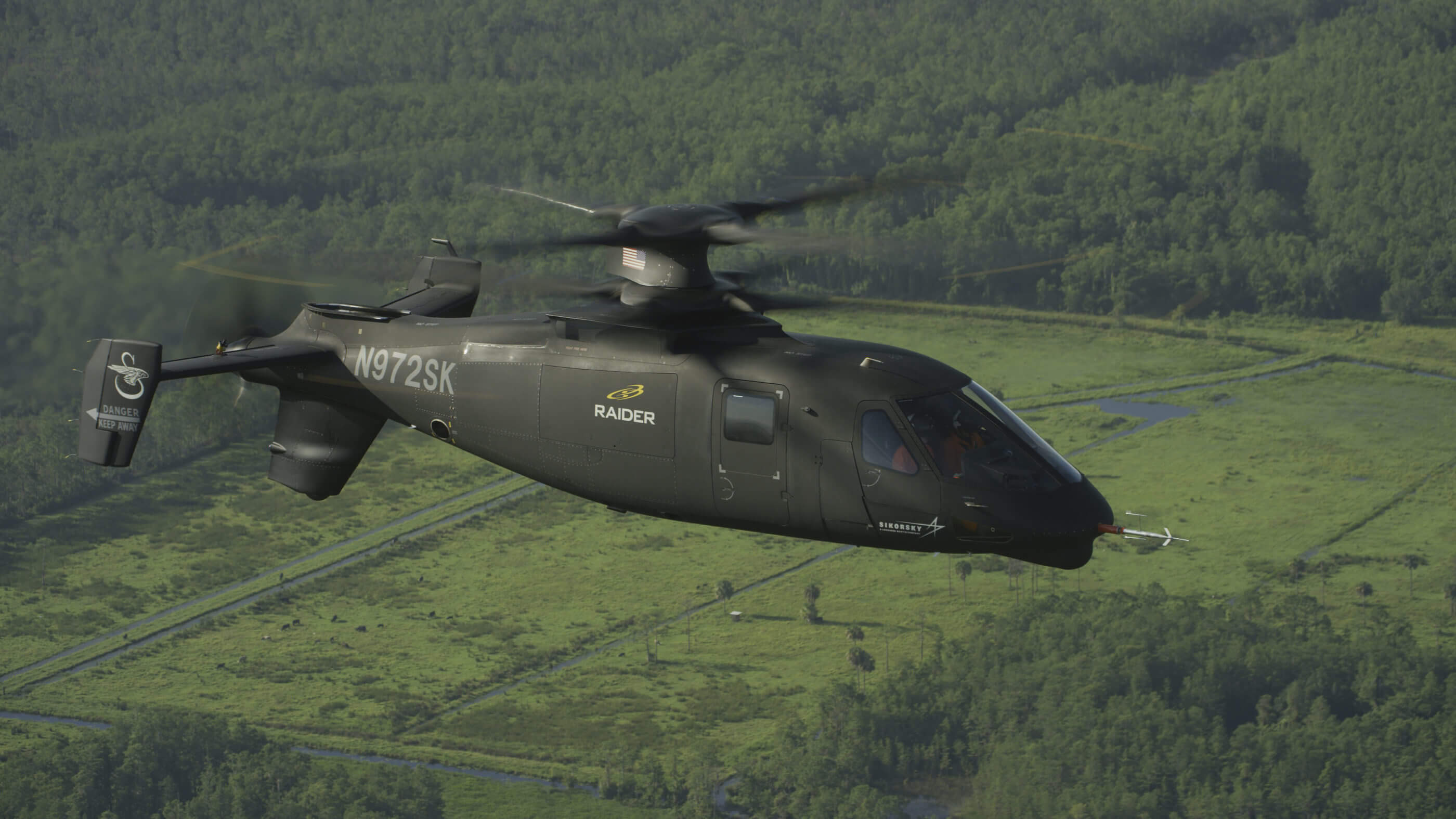The Sikorsky S-97 Raider prototype destroyed by a hard landing in 2017 suffered extreme roll oscillations as the aircraft’s flight control software transitioned from ground to air modes during takeoff, according to the National Transportation Safety Board’s (NTSB’s) newly-released factual report.

The left to right rolls were so severe that the counter-rotating coaxial blades intermeshed and hit each other, “creating a cloud of blade fragments and gray dust,” according to the NTSB’s Helicopter Specialist Report, published April 30.
The NTSB’s report notes that the Raider has three flight control modes, referred to as paths: a fully-on-ground path, a fully-in-air path, and a transition path. If any one of the aircraft’s three wheels are on the ground, the on-ground path is engaged. If all three wheels are off the ground for more than three seconds, the helicopter switches to the fully-in-air path. The two are blended during the transition from air to ground, or ground to air. During the three seconds after the last wheel touches off from the ground, or 0.5 seconds after a wheel touches the ground, the flight controls are in the in-transition path.
The report notes that control law changes were introduced by Sikorsky in late 2015 to improve ground to air transitions.
“An unintended by-product of these changes was an increase of the cyclic stick sensitivity by 2.5 times while operating in the in-transition path,” the report notes.
During the timeline of events in the hard landing, the report states that the left main landing gear briefly contacted the ground during one of the rolls, resetting the transition to flight mode.
“In partnership with the National Transportation Safety Board, we quickly concluded what led to the incident and implemented lessons learned on the Raider program,” Sikorsky said in a statement emailed to Vertical.
The crash took place early in the morning of Aug. 2, 2017, at the Sikorsky Development Flight Center in West Palm Beach, Florida. Sikorsky was expanding the Raider’s flight envelope at the time, having recorded over 100 hours of ground runs and 20 hours of flight testing on the aircraft.
The previous flight had taken the aircraft to 150 knots, with the accident flight scheduled to increase that speed to 180 knots as it engaged the pusher propeller in forward flight for the first time. Sikorsky hoped the following flight would then explore the aircraft’s maximum speed, thought to be over 220 knots.
According to the factual report, the incident happened as the aircraft taxied to the runway to begin the flight. As it approached the runway, the Raider developed a slight left roll, so the pilot-in-command decided to lift it into a five-foot hover to stabilize it.
As he applied collective and got airborne, the helicopter rolled quickly left. He applied counter roll inputs as the aircraft then rolled right and left at increasingly large angles of bank. A large roll to the right took it beyond 60 degrees, and as it banked back left, the pilot lowered the collective to full down to execute a landing, and the Raider hit the ground hard. The whole sequence, from the first slight roll to the landing, took place in less than five seconds.
The two experimental test pilots on board suffered only minor injuries in the event, and were able to exit the aircraft normally after completing the emergency shutdown procedure.
When the NTSB released its initial report into the crash in September 2017, Sikorsky pointed to issues with the flight control software in describing the cause of the hard landing.
In a conference call with media at the time, Chris Van Buiten, vice president of Sikorsky Innovations, referenced the “complex interaction between the ground, the landing gear, the flight control system, and the associated pilot interactions” in describing the incident.
“In fly-by-wire helicopters, there are transitions in the flight controls that happen during the event, and in our analysis of the [hard landing], that transition didn’t go exactly as it should, and we’re making some changes to the flight control system software to accommodate that and ensure that it never happens again,” he said in 2017.
While Sikorsky had previously confirmed the hard landing had significantly damaged the aircraft’s retractable landing gear, the factual report paints a more complete picture. The S-97 also sustained structural cabin damage, and all eight main rotor blades lost four feet off their tips when the coaxial four-bladed rotors, positioned one above the other, intermeshed.
According to the NTSB’s Helicopter Specialist report, the rotors continued to turn for 43 seconds after the aircraft hit the ground. All six blades on the aircraft’s composite pusher propeller were also bent upwards as the tail impacted the ground.
The aircraft returned to flight in June 2018 with the same two pilots, and reached 200 knots airspeed in October 2018.
The Raider first took flight on May 22, 2015, and is based on technology developed in Sikorsky’s X2 demonstrator — most notably its rigid coaxial main rotors and a variable-pitch pusher propeller, which enhance both the aircraft’s speed and its maneuverability.
The U.S. Army recently selected Sikorsky as one of five companies to continue to the next round of its Future Attack Reconnaissance Aircraft (FARA) prototype program, with a design informed by the S-97.
“We look forward to continuing our journey with X2 Technology and demonstrating that high flight speed, and extraordinary maneuverability in the hover and low speed regimes, will dramatically change the way that military aviators fly and fight with helicopters,” said Sikorsky.










Outstanding! Sikorsky bounced back from this and the Raider is the future!
Maybe! Maybe not!
So thankful that the test pilots managed to ‘land’ safely and they were not seriously injured even though the S-97 Raider was damaged.